Minarets of Prominence: Umayyad, Abbasid and Safavid Dynasties
You may be wondering what is the difference between Umayyad and Islamic architecture? The former derives from the Umayyads, the early Arab Muslim caliphs, the latter from the Abbasid Arabs - who, along with their Iranian supporters (and co-founders of new Persia), ended the era of Umayyad rule in AD 750 and continued to influence architecture well into the future.
The Abbasid Caliphate was a Sunni Muslim dynasty, with Baghdad as its original capital.
The Umayyad, Abbasid and Safavid periods represent two distinct generations in the history of Muslim civilisation: the dawn of Islam, a golden age that bridged both Byzantine and Sasanian culture into the Islamic empire, and a later period of the Iranian renaissance.
There is something almost stately about minarets, a kind of formality that seems to derive from the purpose of their existence in the Middle Ages. They are not only decorative elements or symbols, but also the towers that lead prayers to Allah. Two of the most important aspects of this cultural revolution can be illustrated by the most outstanding minarets of the time - the Great Mosque of Damascus in Syria and the Great Mosque of Samarra in Iraq.
Umayyad Mosque - Damascus, Syria
A large monumental gate gave access to Damascus in Syria. On entering, columns of pale pink and green porphyry, jasper, granite and perhaps alabaster, bearing floral capitals and supporting a continuous balcony or arcade, could be seen on either side of the main street. On either side were shops that faced the markets and stretched over several floors. From these levels, one could watch sailors mooring their ships at the quays and passengers being escorted to the waiting camels. Leaving the markets, one soon noticed the minarets of the great mosques dominating the skyline.
The Great Mosque of Damascus, also known as the Umayyad Mosque, is a palatial structure strong enough to withstand an earthquake that is extravagant in its furnishings. This was, and still is, the case for mosques all over the world, from Constantinople and Cairo to Cordoba and Samarkand. None of the early mosques have survived, and no descriptions of the smaller ones have been preserved. However, accurate textual descriptions of the great communal buildings constructed in Kūfah and Basra in Iraq and in Al-Fusṭāṭ in Egypt remain.
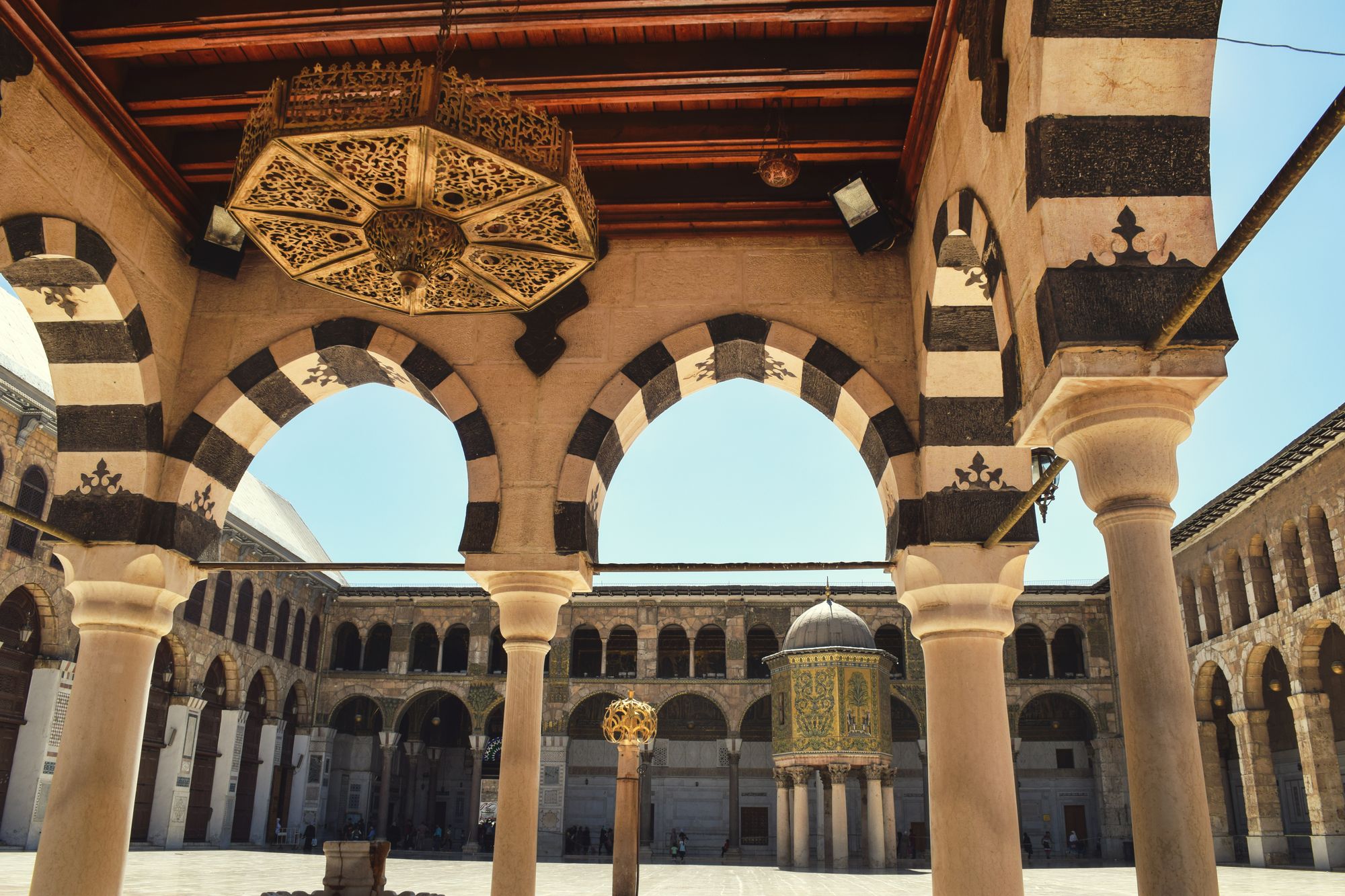
Of all the outstanding minarets, those of the 715 AD Umayyad Mosque are the first to come to mind. It is one of the oldest and largest mosques in the world and was built in different architectural styles according to different occasions throughout history.
Unlike the Al-Aqṣā in Jerusalem, the Great Mosque at Damascus was never fully converted for private use. In its current form it strikingly preserves the character and appearance of an 11th-century mosque.
In comparison, the Al-Aqṣā Mosque consisted of an indefinite number of interior rooms (possibly as many as 15) arranged parallel to each other in a north-south direction. There was no inner courtyard, because the rest of the huge esplanade of the former Jewish temple served as an open space in front of the building.
The Umayyad Mosque of Damascus is a rectangle (157 by 100 metres). The interior consists of an open space surrounded by a portico on three sides and a covered space of three naves of equal length parallel to the qibla wall, intersected in the middle by a perpendicular interior. The mosque was commissioned by the sixth Umayyad Caliph, Al-Walid I, who reigned from 705 to 715.
The buildings share several important characteristics. They are both large spaces with a variety of internal supports, they have flexibility and easy internal communication characteristic of a hypostyle building (where the interior rests on pillars or columns).
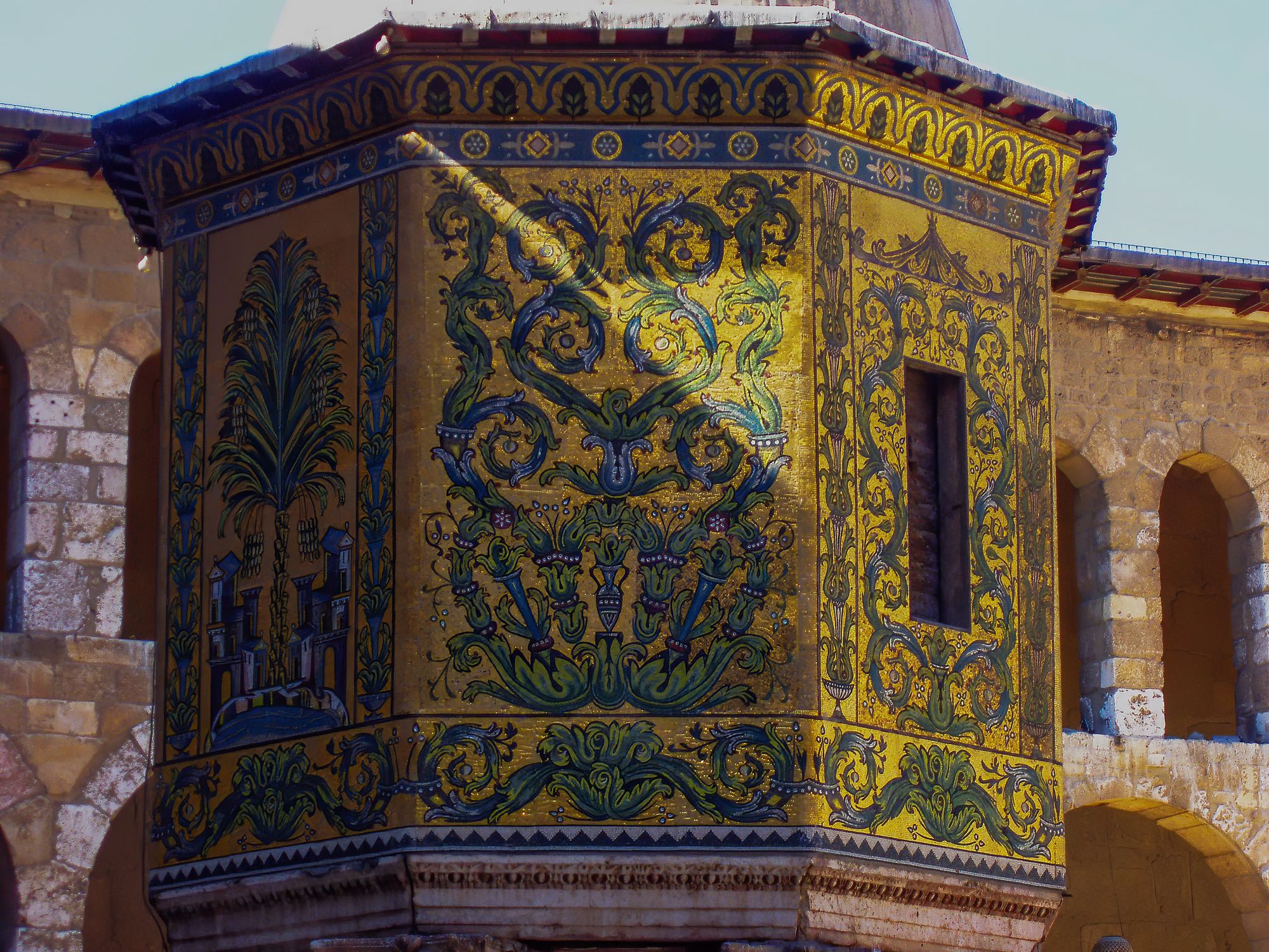
Minarets of the Umayyad Mosque
Located in the old city of Damascus, the Umayyad Mosque is a must-see for any traveller looking to experience the best that Syria has to offer. Though many see this ancient site as a drastic departure from the country's modernity, there are a few distinctive minarets that are worth seeing:
Minaret of the Bride (Madhanat al-'Arus)
- It is located on the west side of the courtyard, between the minarets of Jewels and that of Prayer.
- It is the oldest of the three minarets.
- The top floor of the minaret has a balcony with an inscription dedicating it to Caliph al-Mutawakkil.
Minaret of Isa
- At 77 metres high, it is the tallest of the mosque's three minarets.
- The square-shaped main body is crowned by an octagonal spire, tapering to a point and surmounted by a crescent.
- Some sources claim it was originally built by the Abbasids in the 9th century, while others attribute the original structure to the Umayyads.
- The main body of the current minaret was built by the Ayyubids and the upper section by the Ottomans.
Minaret of Qaitbay (Madhanat al-Gharbiyya)
- The Western Minaret is also known as the Minaret of Qaitbay as it was built by Mamluk Sultan Qaitbay in 1488.
- The minaret is octagonal in shape and is built in receding sections with three galleries.
- It is generally believed that both the Minaret of Jesus and the Western Minaret were built on the foundations of ancient Roman towers (temenos), although some scholars question this given the lack of corner towers in other former Roman temples.
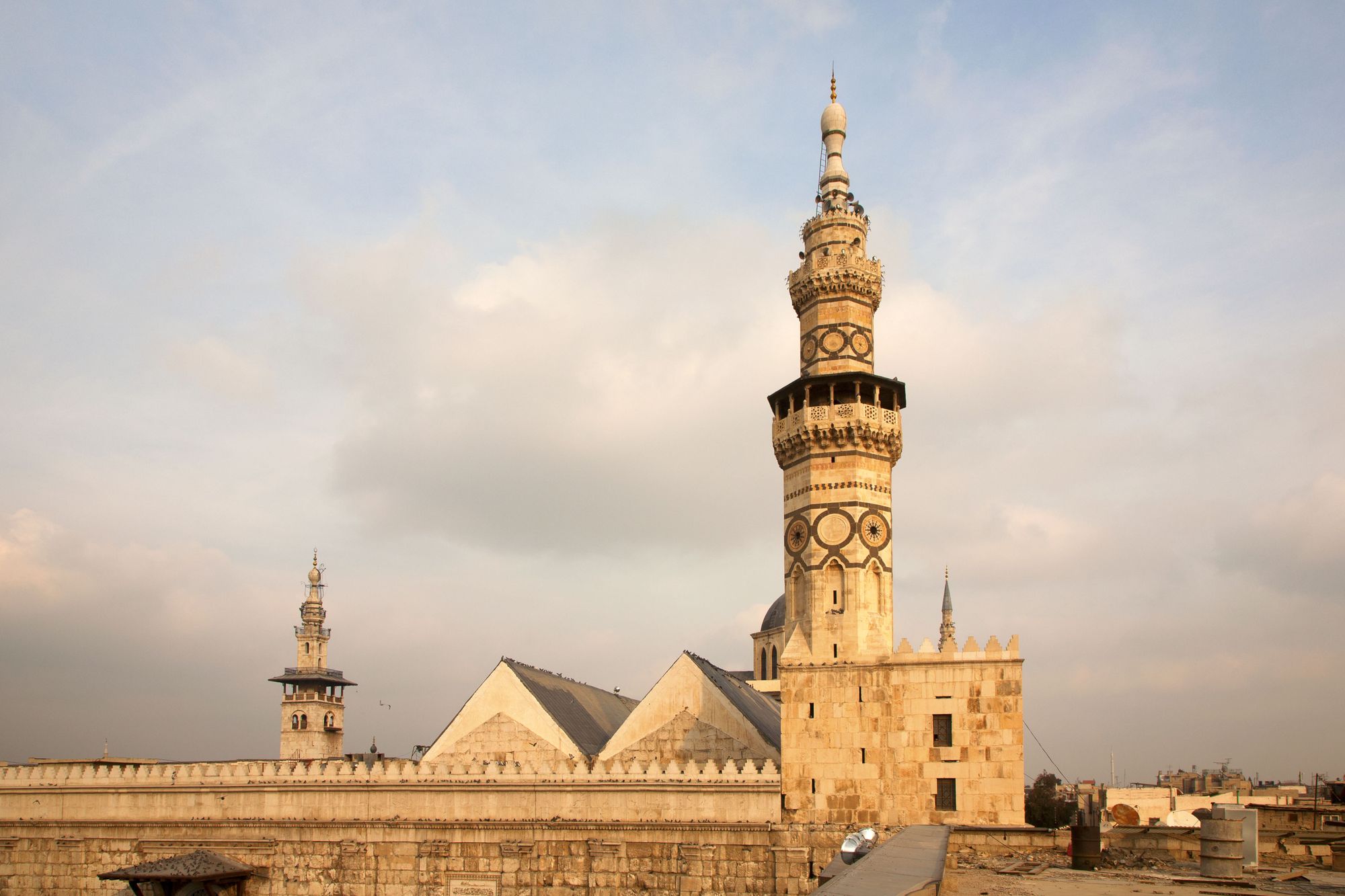
Dome of the Rock - Jerusalem
The Dome of the Rock in Jerusalem is a unique building. This masterpiece of Islamic architecture is the earliest major Islamic monument. Its octagonal plan, use of a high dome and building techniques are hardly original, although its decoration is unique.
No building symbolises this final act of the Islamic conquest of Jerusalem better than the Dome of the Rock. When Caliph Abd al-Malik, a major Umayyad Caliph, completed this work in 692, he was fulfilling a vow to build a temple at the holiest site in Judaism and Christianity. What took shape over these 46 years was no simple shrine to Allah, but an ornate monument representing Islam’s destiny to succeed Judaism and Christianity, yet without wiping out their contributions to a universal civilisation.
The most remarkable aspect about the building, however, is Its purpose. Since the mid-8th century, the Dome of the Rock has become the focal point of the most mystical event in the Prophet’s life: his ascension from the rock around which the edifice was built. Its surroundings are enough to leave a lasting impression on anyone who sees it or even hears about it for the first time.
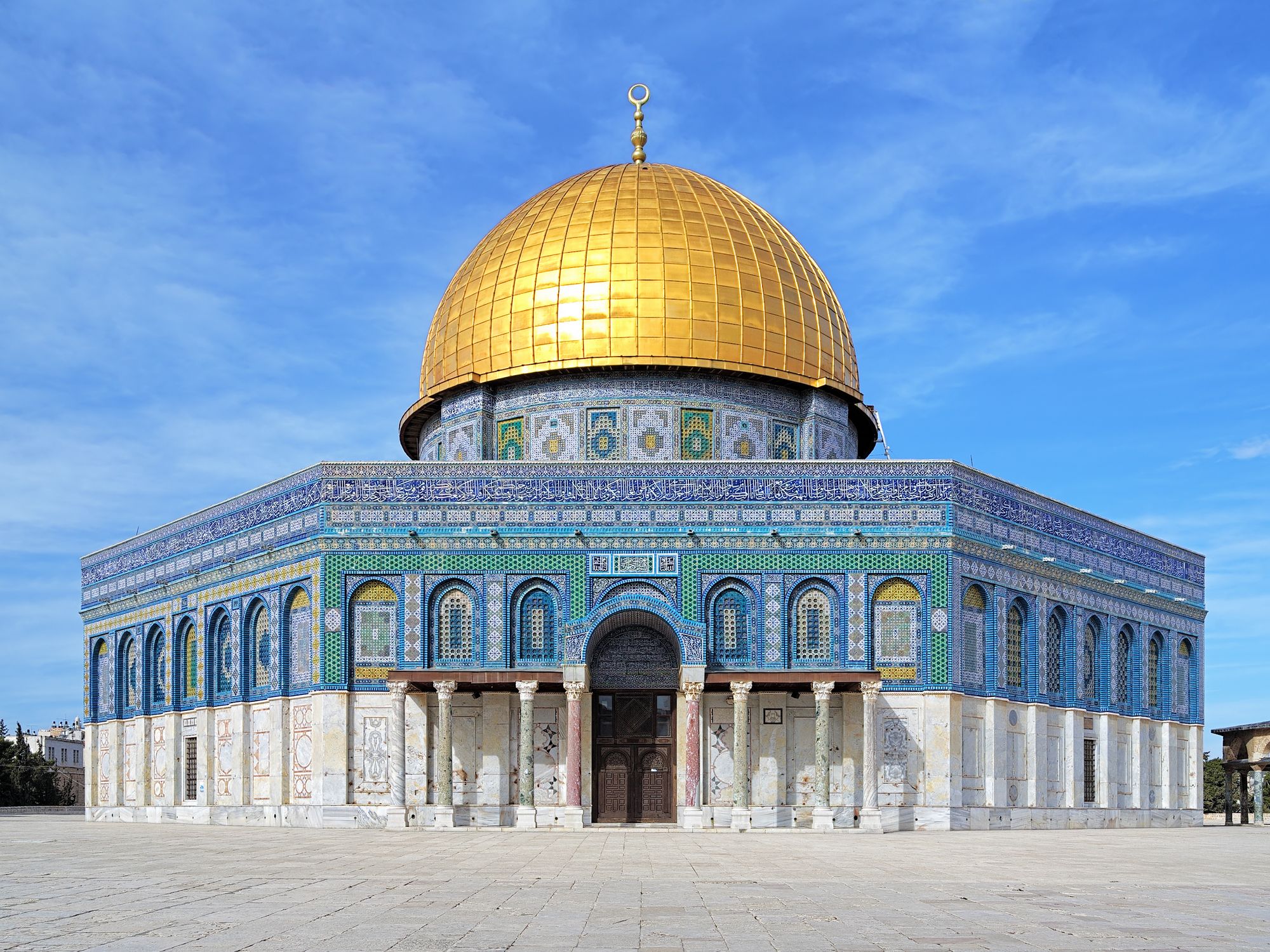
The Dome of the Rock is one of the oldest Islamic monuments still standing. With a height of 33 metres it is a symbol of the city. The original name of this architectural marvel is Qubbat as-Sakhrah. Built to protect and commemorate a sacred relic for hundreds of years, the beautiful colossal structure rests on solid foundations.
Located in the Muslim Quarter of the Old City of Jerusalem, the Al-Aqsa Mosque is one of the city’s most important landmarks and a symbol of Islam’s commitment to the sacredness of Jerusalem and its holy sites. Its impressive structure, beautiful decorations and well-kept gardens make this structure to be one of the most important tangible heritage sites in Jerusalem today.
The Safavid Empire
The Safavid dynasty was one of the greatest ever in Iran, founded by Ṣafi-al-din, son of a Kurdish commoner. The empire of the Persian Sunni Muslim dynasty existed mainly and for a long time in the heart of areas inhabited by large ethnic and religious communities such as the Qizilbash Turks and various Shia communities.
The main centres of the Safavid Empire were Tabrīz and Ardabīl in the northwest, with Kazvin in the central region and Eṣfahān in particular in the west. The Safavid period, like the Ottoman era, was an imperial era and there is hardly a part of Iran that does not contain Safavid buildings or significant Safavid restorations.
Two of the most famous mosques, Sheikh Lotfollah Mosque and Shah Mosque built during the Safavid dynasty in Iran are a must see!
Shah Mosque, Isfahan
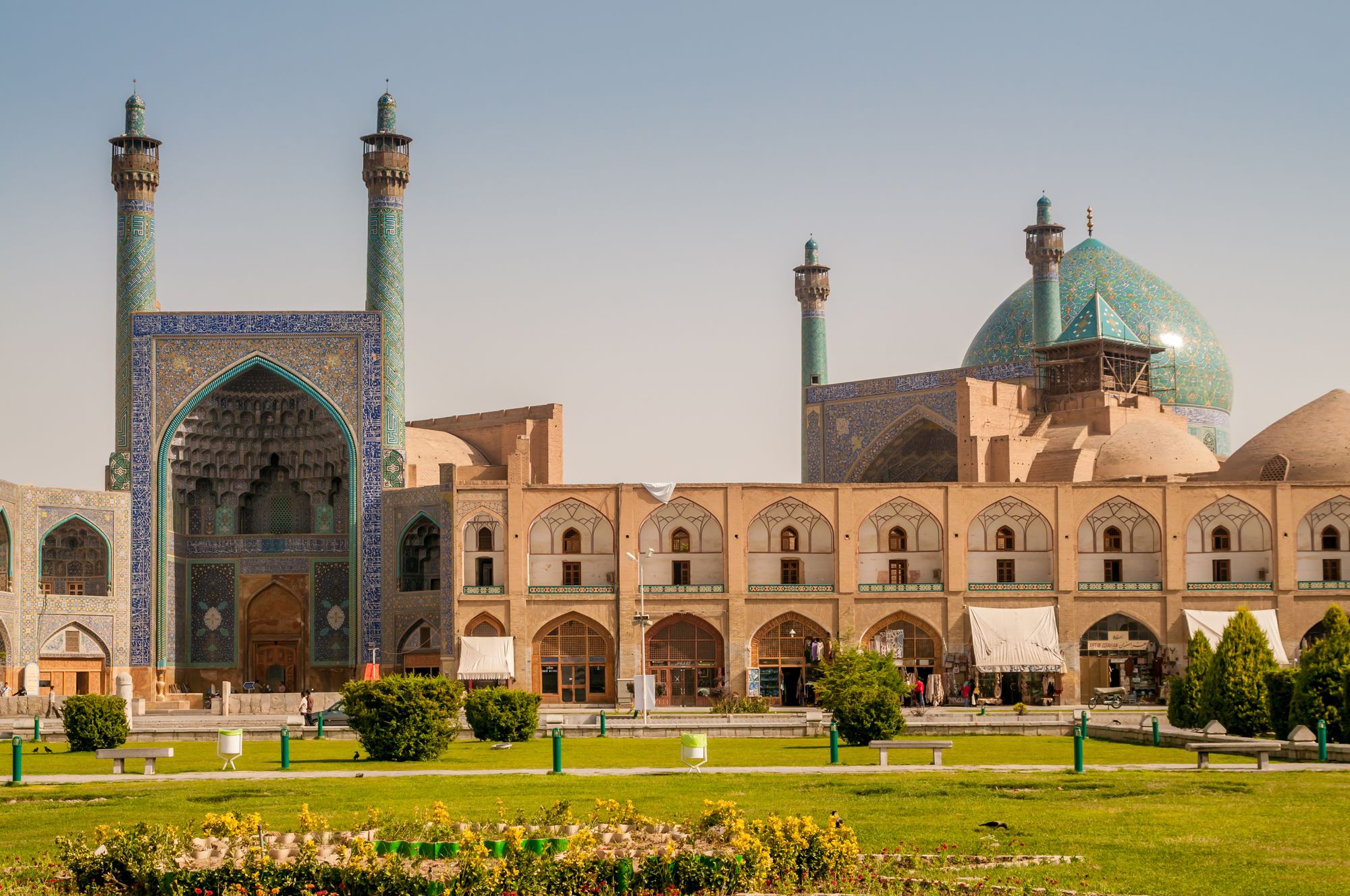
- Also known as Sultani Mosque and Abbasi Jame Mosque.
- It was named Imam mosque after the Islamic Revolution in Iran.
- Located at the heart of the city Isfahan alongside the Naqsh-e-Jahan square.
- Considered one of the most important historical mosques in Isfahan.
- Built during the Safavid era under the rule of Shah Abbas the Safavid King in 1611.
Sheikh Lotfollah Mosque, Isfahan
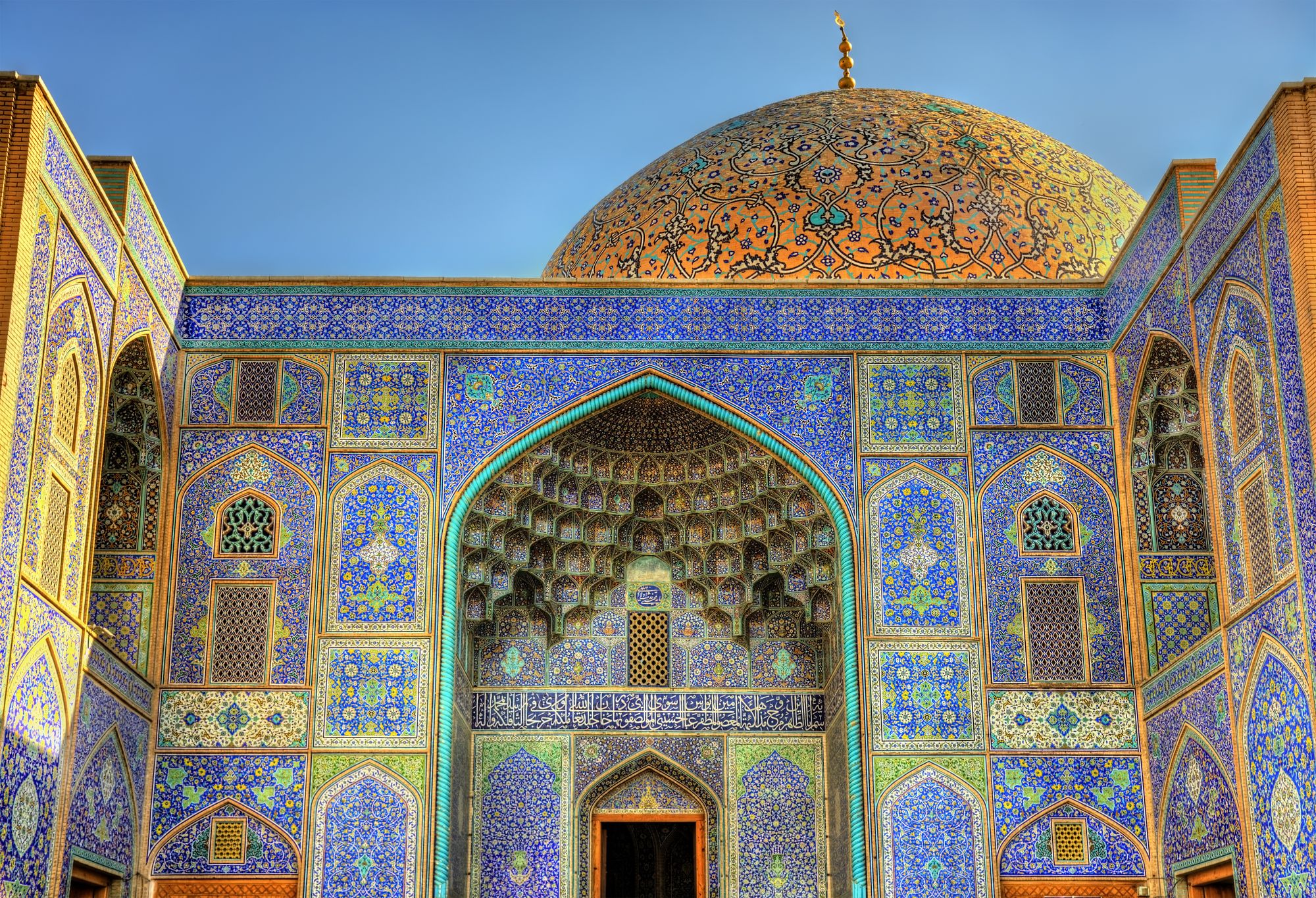
- An architectural masterpiece of Iranian architecture built during the Safavid Empire.
- Construction began in early 1603 and was completed in 1619 by Shaykh Bahai during the reign of Shah Abbas I .
- Of the four monuments that dominated the perimeter of the Naqsh-e Jahan Square, this one was the first to be built.
- Located on the eastern side of Naghsh-i Jahan Square.
- It was made for private use by the royal court. It has no minarets and is smaller and more privatised than the Shah Mosque, which was intended for public use. This beautiful mosque and its exquisite tile-work was originally intended only for the women of the court. Today the mosque is open to the public.
Master calligrapher Ali Reza Abbasi oversaw the stunning creation of the calligraphy and tiling, which surpasses in beauty and quality anything previously created in the Islamic world. Contrasting with the simple structure of this mosque, the interior and exterior decoration is extremely complex, and the finest materials were used and the most talented craftsmen were employed in its construction.
The structure of the dome of Lotfollah mosque and the Blue Mosque of Tabriz is believed to be derived from that of the Shah Vali mosque of Taft in Yazd.
The mosque’s inscriptions reflect matters preoccupying the shah at the time it was built. Namely the need to define Twelver Shiism in contrast to Sunni Islam and Persian resistance to Ottoman invasion. The design of the interior of the dome also inspired the design of Azadi Square in Tehran.
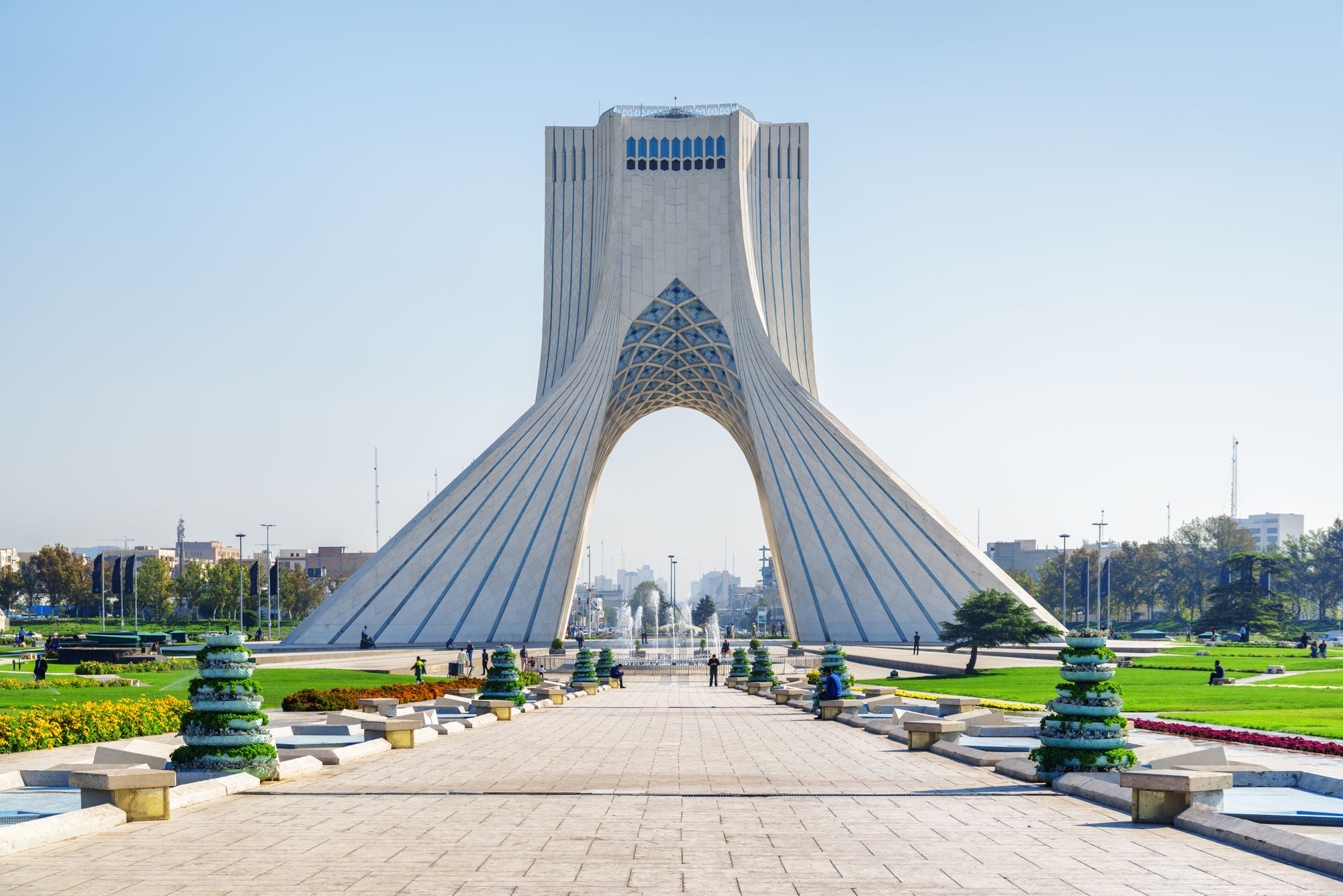
The design of the Ardabil Carpet followed the same concept as that of the inside of the dome.
Another important neighbour and also a Safavid structure is the Ali Qapu Palace.
Great Mosque of Samarra & Abu Dulaf Mosque, Iraq
The Great Mosque of Samarra and the Abu Dulaf Mosque feature iconic 9th-century spiral minarets. They testify to the architectural and artistic innovations developed in the Iraqi region and have inspired landmark structures around the world. In 1976, these minarets were so inspirational that in 2007 the two structures were added to the UNESCO World Heritage Site as part of the Samarra Archaeological City.
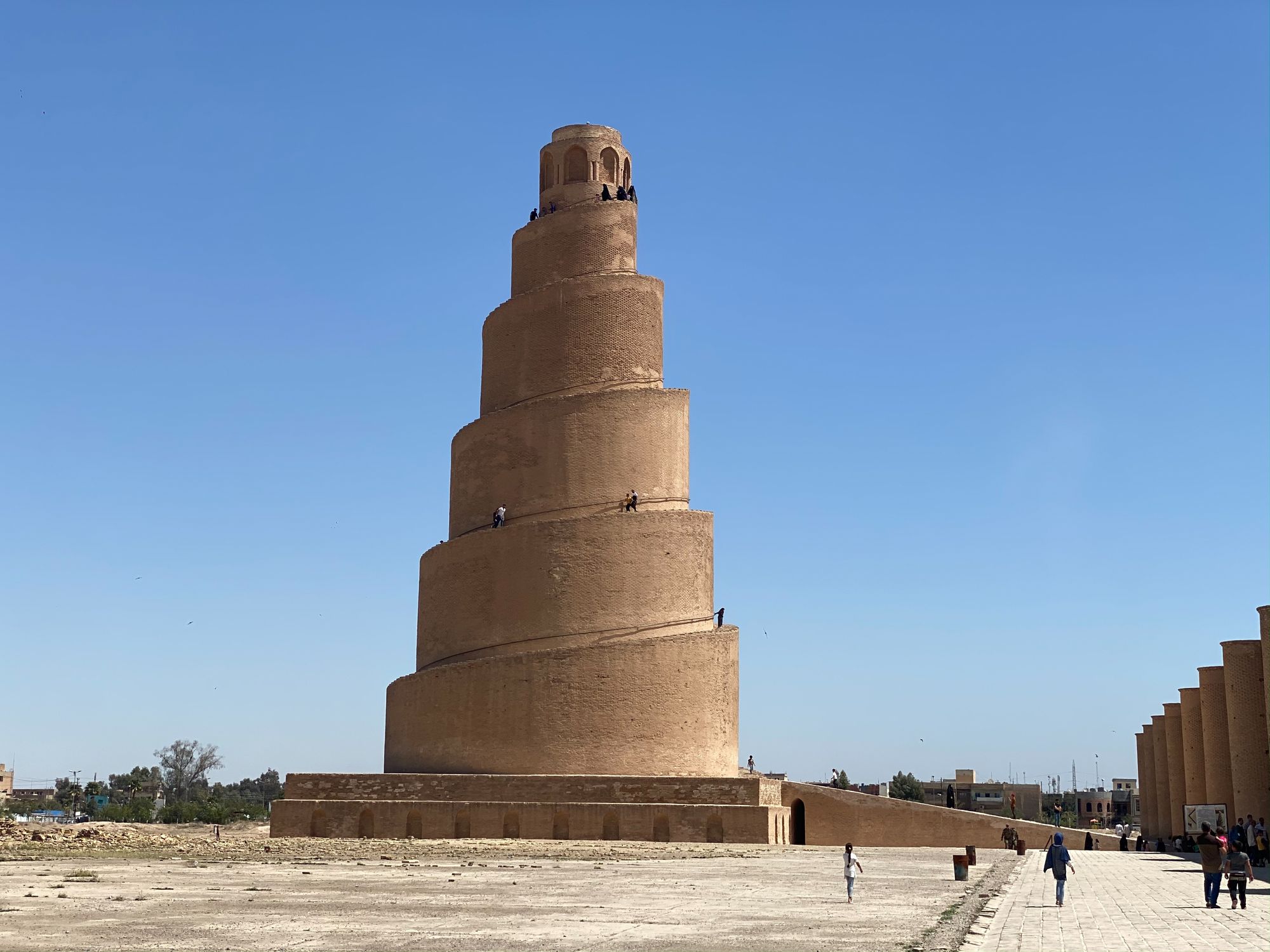
The iconic Great Mosque of Samarra was at one time the largest mosque in the world. It features a unique spiral minaret, the Malwiya Tower, built by the Abbasid Caliph Al-Mutawakkil between 848 and 852 AD. It is a spiral cone that is 52 metres high and 33 metres wide with a spiral ramp that has been compared to an ancient Egyptian pyramid and remains one of Iraq's most popular tourist attractions to this day. The style was derived from the minarets of Syria and Persia.
The Malwiya Tower is an architectural masterpiece. Its spiral shape and artistic construction make it one of the most important architectural achievements of the Abbasids in antiquity. The construction of two mosques within a 20-year time difference was the symbol of the faith and power of the region.
The Abu Dulaf Mosque was built between 849 (235 AH) and 851 (235 AH) and is part of the eastward expansion of the city. The mosque itself was destroyed in 1278 (656 AH) after Hulagu Khan invaded Iraq, and this dates to the period when the Caliphate's seat was briefly moved from Samarra to Baghdad. Only the outer wall and its minaret remain. It became the new congregational mosque serving the Samarra Grand Mosque during this short two-year period. The Abu Dulaf Mosque follows almost the same model, but the plan of the complex is better preserved.
These Minarets of Prominence with all their splendour, grandeur and majestic beauty are highly recommended. Even if you would visit them once in a lifetime it would be an event you will never forget.
